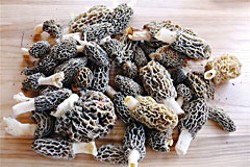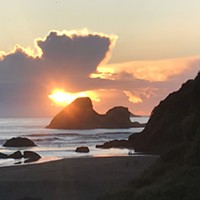[
{
"name": "Top Stories Video Pair",
"insertPoint": "7",
"component": "17087298",
"parentWrapperClass": "fdn-ads-inline-content-block",
"requiredCountToDisplay": "1"
}
]
Winters are horrible back East and I used to dread them. Here in Humboldt, though, the first rains of fall bring out the mushrooms, and the rest of the season is an Easter egg hunt. I love to disappear into the damp green woods while the rest of the nation freezes. It's a thrill to go into a familiar forest where I know individual logs, stream courses, hillsides, trees and snags as well as you might know your own pantry or workshop. The woods are my sanctuary. Perhaps this is why I am so attracted to the commercial mushroom business.
Larry Alameda grew up on the Yurok Reservation by the Klamath River and first found and tasted mushrooms as a boy. He was poor, and the family often fell back on foods from the woods. His first edibles were the field mushrooms, members of the Agaricus order (the commercial button or table mushroom is Agaricus bisporus) that he picked in cow pastures and yards. Larry still loves to sauté them in butter and onions with deer meat.
I went picking with Larry by the Trinities a few springs ago and it was glorious. He is amazing. Lanky and fast in the woods, he picks mushrooms that I cannot even see. We were in a dry upland fir forest and the woods were covered with cones. Morels are remarkably similar to fir cones, and it is headache-inducing trying to distinguish them. Larry would pick a half dozen while I just stared at the patterns on the dappled forest floor, trying to make sense of it all.
Larry sold his first mushroom more than 20 years ago in Hoopa when the Japanese matsutake market was just opening up. The Japanese were paying up to $100 per pound for the perfect specimens in those days. Larry remembers selling matsutakes between $10 and $20 per pound for two months in 1997 and taking home $400-$500 a day. Now that market has all but collapsed.
When I talked to him in early December, he was getting only $1.50 per pound for the most valuable buttons, "the number ones, the unbroken veils." Larry says his return on this year's bumper harvest was "incredibly low, the worst ever." That's because matsutakes (and various closely related subspecies) have become available all over the world at the same latitude and climate region. So the mushroom we call "tan oak" (here in the coastal mountains where they grow under the deciduous hardwood of the same name) or the "pine mushroom" (in the Cascades inland) is now harvested in ex-Communist countries (Tibet, China and Russia) as well as Korea, Sweden, Japan and the United States. Worse for the market, the flushes seem to coincide all over the Northern Hemisphere, and so North America only gets a good price when other regions fail. Only 20 percent of Larry's business is now in matsutakes.
So now Larry picks a whole range of mushrooms and has a variety of markets that change with the seasons. It begins under the fog drip in coastal forests where the first chanterelles pop in late summer. This small harvest might end up at the Co-op or one of our local restaurants. I love these chanterelles. They are small and perfectly fluted like orange morning glories, and are the best to cook, being firm, dense, dry and sweet. The "Prince," the stately Agaricus augustus, also comes up in mid-summer, but this elusive giant (I've collected perfect one-pound buttons), a relative of the supermarket button, is too rare to make it a market. It's a shame, as it is one of the most distinctive edibles with a powerful and pungent aroma of almond marzipan.
Once the rains begin in earnest, usually in late September and early October, Larry's season goes into high gear. Boletes on the coast and the mountains (the King in the spruces and the Queen in the firs), the delicious Amanita coccora (a very close relative of the killer shrooms Death Cap and Destroying Angel, and beloved of the Italian community), followed by the matsutake, hedgehog, candy cap and finally, in late winter, yellowfoot chanterelles and black trumpets.
Larry sells most of his winter mushrooms to Trent Valvo, the founder and owner of Sierra Madre Mushroom Company in Bayside. Trent recently drove three tons of chanterelles to the San Francisco airport in a refrigerator truck. They are destined for France.
The morel in late spring is Larry's favorite mushroom, and mine too. He likes to cook the morel with the wild spring onion, the ramp. Finding morels is a peak mushroom experience. It's completely different than other mushrooms — kind of opposite. For instance, in the fall the first matsutakes are at high elevation because they need cold weather and lots of water to fruit. As the winter progresses, the cold and rain move down into the inland valleys.
Morels, on the other hand, require a long winter, followed by 80 degree days and plenty of water. So the first scant morels pop in the warm wet valley floors with the first heat of spring. As the days grow long and the land heats up, the snow melts and the morels move up the mountains. These are the big flushes. Larry said his favorite mushrooming is at 4,000 to 5,000 feet.
"I can hear snow melting, waterfalls, and the sound of the woodpeckers," he said.
Larry explained that both morels and woodpeckers love fires because they both thrive on dead trees — morels on the extra compost and nutrients in the soil, and the birds on the beetles in the rotting wood. Other than the truffle, the morel is the most sought-after and often fetches $15-20 pound.
Something to look forward to during the winter's wettest and coldest days.
Speaking of Outdoors
Comments (2)
Showing 1-2 of 2
more from the author
-
North to Alaska
In which Dan the Faller Man escapes the choker-setting life
- Mar 13, 2008
-
My Worst Job
In which Dan the Faller Man remembers his choker-setter days
- Feb 28, 2008
-
Ab Fab
Stalking the abalone, and living to tell the tale
- Feb 14, 2008
- More »



































